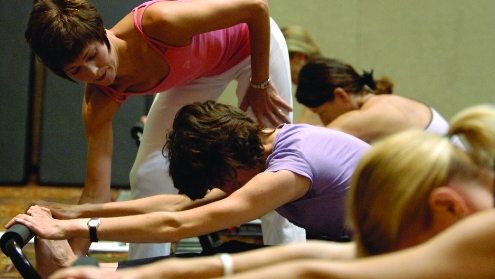4 Core Challenges of Running a Pilates Business
Your success is likely to depend on how you handle business planning, facility selection, staffing and customer service.

Just ask Pilates trainer and business consultant Michael King, of London, how far the Pilates boom has spread. “There’s no place where there isn’t Pilates these days,” he says. “I just helped open studios in Turkey. We have teachers in Mongolia, in India—I haven’t come across a country yet that hasn’t had some form of Pilates. It has been in the UK for 30 years. France is going crazy for Pilates. But it’s a little different everywhere you go, depending on how the press promote it. Sometimes it’s more of a fitness program; sometimes it’s about rehab or has a more glamorous image.”
King is a founder and director of Pilates Institute UK, and he travels around the globe assisting Pilates businesses with training and operations. Just as every country approaches Pilates differently, no two studios are alike, he says.
“The main thing is that it’s a business,” says King. “Just because it’s been in Vogue doesn’t mean it’s not a business. Without a doubt, everyone loves the technique. It’s never really about that—it’s about how to make it work. And now there’s more competition than ever before, so the challenges are different than they were when you could be the only one.”
For Pilates businesses today, the biggest hurdles tend to fall into four crucial areas: business planning, facility
selection, staffing and customer service.
Core Challenge #1: Business Planning
King says the biggest mistake he made, and the one he sees most often, is thinking success will happen quickly, rather than being prepared for a more realistic picture. “I thought all you have to do is have a studio with pretty paint and equipment, and people will come. Now I know you need very serious planning. Most studios take about 2 years to build a good client base.”
Catherine Logan, MSPT, of Hanover, New Hampshire, is presenting a session on launching a Pilates business at the upcoming Inner IDEA Conference® (see the sidebar on page 114 for details) and is also writing a book on the topic. “There’s a big demand to get Pilates out there quick, but people don’t realize it’s all about preparation,” she says. “You need to start at least a year in advance.”
Research your target market carefully, Logan advises. “My first business was in a college town, and I had to cater to a college schedule and young people working later hours. My fees had to fit into their budget. You can’t build your business around what you want; [it has to be] around what your target clients want.”
Formal market research can be expensive, but Logan says you can get around that. “I use an online company called Surveymonkey.com, which offers free market surveys. You can send out a link to friends and have them pass it on to their friends. I’m also a big believer in incentives. I do raffles and offer prizes like free classes and T-shirts.”
Core Challenge #2:
Facility Selection
For most Pilates businesses, finances depend primarily on one factor: facility cost. “The facility is usually the biggest expense,” says King. “I always recommend that people start small. There’s a huge amount of pressure when people open a big rented studio. You have to remember your business isn’t about the building; it’s about what you’re doing there. You can’t enjoy what you’re doing if you’re too stressed by that monthly rent.”
He tells the story of a teacher in Scotland who turned her living room into a Pilates studio. “The family had to watch TV in the bedroom for a while, but she made enough money in 1 year to build an extension onto her house. It’s a fantastic scenario. That’s why home-based studios are becoming more popular. The smallest place for a working studio that I know of is 10 feet by 6 feet with one piece of equipment.”
Negotiate, negotiate, negotiate, emphasizes King. “Try to get part of the lease free, or get the facility to take a percentage split. It will give you more breathing room.”
Logan solved the problem by sharing space. “I rented a space within a community center. I rented it by the hour, so I didn’t even pay utilities. Later I added another site at an all-purpose room on a college campus. I could start making money right away, which is a good way to go if you don’t want to look for investors.”
Portia Page is co-owner—with Bruno Bosardi and Gaynor Dalbratt—of BPG Bodies, a Pilates studio in the trendy Hillcrest area of San Diego. She kept it small: 400 square feet, and she teaches 12 Pilates group classes a week, with 75 people coming in regularly. “It’s basically a wooden floor with mirrors on one wall. My rent is still my biggest expense, since this is a popular area. But it’s worth it because we get a lot of foot traffic by the studio.”
Leslee Bender of Reno, Nevada—founder of the Bender Method, Bender Ball™ training and The Pilates Coach—started her studio in a gym. “It gave us a lot of exposure because it was in a good spot and members could see what was going on—rather than having it tucked away in some dark corner.”
Bender went on to open the first full-service Pilates studio in Reno: a 2,500-square-foot stand-alone facility, where she has six towers, a Cadillac chair and seven reformers. “We’re well-established now, but Pilates studios are opening up like fast-food chains, with trainers who’ve studied for a weekend. It’s frightening,” she says. “It makes it more important than ever for us to offer high-quality service.”
While competition can create a tight market for start-ups, the good news is that financial institutions may be more willing to lend a hand. “Five years ago it was hard to get a loan, but now most banks have heard about Pilates. It’s proved its worth,” says King.
Another advantage of Pilates’ popularity: you may be able to save money by finding good secondhand equipment. “I think used equipment can be a great idea,” King says. “Check eBay. I do it all the time.”
Core Challenge #3: Staffing
Christine Romani-Ruby, MPT, of Monongahela, Pennsylvania, owns PowerHouse Pilates, a combined Pilates studio and Pilates-based physical therapy clinic. The facility is located above a physical therapy clinic that offers more conventional modalities, and the two businesses refer back and forth. She is also the founder of PHI Pilates, which offers Pilates training to fitness professionals and physical therapists.
She says: “The number-one challenge for most Pilates businesses seems to be staffing—finding people who are not only certified but talented enough to think on their feet and responsible enough to take care of clients. It’s not easy to find professionals who will treat your clients the way you treat them.”
Romani-Ruby believes that the number of trained, experienced instructors just hasn’t caught up to the demand. She has a number of suggestions for overcoming staffing hurdles. “I think the best way is to build a relationship with an educator. I know that when facilities call us for help, we send out e-mail blasts to our database of 6,000 instructors. Hosting a training is another great way to get to know potential candidates.”
She advises looking for instructors who have both personality and work ethic, who can be polite to customers and also get to work on time. “If you find [people] like that, it’s worth spending the time to train them.”
King notes that one current trend for solving staffing challenges is renting space to instructors by the hour and leaving it up to them to bring in clients.
Bender says staffing is her biggest challenge, too. “The key to a successful studio is a team. You can have the best equipment and most hoity-toity studio, but if your trainers have attitude, you’re going to have problems.”
Bender believes negative comments about other instructors and techniques can be a problem in the Pilates industry, and she looks for positive, open-minded teachers. “I hire team players, instead of people who think there’s only one way of [doing] Pilates that’s right, or who might badmouth other instructors. We all have to be able to think outside of the box for each client.”
Page, who has worked in Pilates studios in Thailand and Korea, says staffing is a challenge the world over. “The same thing applied there—you needed to find people who could bring in students and have good people skills.”
Core Challenge #4: Getting and Keeping Clients
The real bottom line for a successful Pilates business is the response of clients. “A studio is not just about equipment and training; it’s about people,” King says. “We’re in a customer service industry. We forget that.”
King believes that the most successful studios he’s seen—the ones that are completely full—offer a wide variety of training types and levels to appeal to a broad range of clients. “You need to offer variety. The reality is that Pilates is not just gorgeous people doing complicated moves. You’re going to get overweight clients, aging people, injured people. You need to market an image of caring and helping people feel better, not just [look] a certain way. It’s good to take a more mind-body approach rather than just
focus on technique.”
Romani-Ruby has had success with tailoring her services and fees to the needs of the community. “We’re in an economically depressed area, so we
offer packages that make our services
affordable but also lock clients into a
certain number of visits. If we can get them to come five or six times, instead of just once, it helps retention.”
She also offers at-home programs for clients who want to come in just once a month. “We give them written instructions and sometimes sell them DVDs or equipment. We do whatever we can to help our clients, and it’s allowed us to be successful despite our location. Most of our clients come to us through a healthcare door. They’ve been injured or just had a baby, for example. We take a wellness approach more than a fitness
approach, and we keep our focus on doing the best we can for our clients.”
Logan advises owners never to stop seeking feedback from their customer base. The biggest danger lies in not honestly evaluating yourself or your business, she says. “If you just listen to everyone saying, ‘Oh, I love your classes!’ you’re not
going to hear negative feedback or constructive criticism. Even doing seemingly small things, like making the floors cleaner or addressing too much chatting in class, can make a big difference. The worst thing is to take the attitude of, ‘If they don’t like it, they can go somewhere else.’”
With the growing competition in the Pilates field, the best solution is to offer quality, above all else, Bender says. “It’s more important than ever to do what competitors can’t or won’t, such as full postural assessments or body type analysis.”
Offering a personal touch doesn’t hurt either, she notes. “I believe we are a people business in a computer-obsessed society. At our studio, we answer the phone, send thank-you notes, call and ask clients where they’ve been. Our front-desk person knows everyone by name.”
All challenges aside, this is a good time for Pilates businesses. “If you can keep costs down, offer consistency and maintain a high standard of quality and training, you can have a successful studio,” says King.
That’s good news for fitness professionals who are passionate about Pilates. “Seeing how you can change people’s lives is the best thing,” says Page. “If you [had] told me I’d own a Pilates business, I would have thought you were crazy. But that’s
exactly what I’m doing, and I love it.”
Sidebar: Launching A Successful Pilates Business
On Friday, September 7, at the Inner IDEA Conference in Palm Springs, California, Catherine Logan, MSPT, will present “Launch: Your Guide to a Mind, Body, Spirit Start-Up Business.” The session will focus on ways to ensure that your new Pilates venture succeeds.





